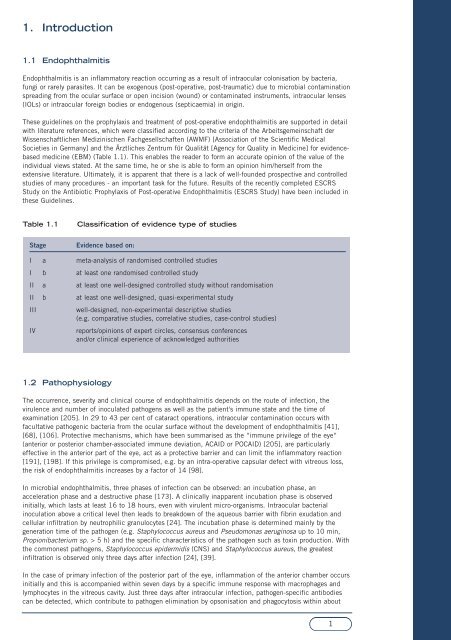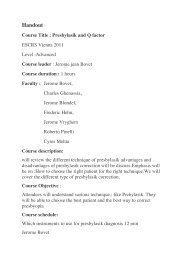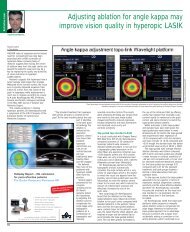ESCRS Guidelines on prevention, investigation and management of
ESCRS Guidelines on prevention, investigation and management of
ESCRS Guidelines on prevention, investigation and management of
You also want an ePaper? Increase the reach of your titles
YUMPU automatically turns print PDFs into web optimized ePapers that Google loves.
1. Introducti<strong>on</strong><br />
1.1 Endophthalmitis<br />
Endophthalmitis is an inflammatory reacti<strong>on</strong> occurring as a result <strong>of</strong> intraocular col<strong>on</strong>isati<strong>on</strong> by bacteria,<br />
fungi or rarely parasites. It can be exogenous (post-operative, post-traumatic) due to microbial c<strong>on</strong>taminati<strong>on</strong><br />
spreading from the ocular surface or open incisi<strong>on</strong> (wound) or c<strong>on</strong>taminated instruments, intraocular lenses<br />
(IOLs) or intraocular foreign bodies or endogenous (septicaemia) in origin.<br />
These guidelines <strong>on</strong> the prophylaxis <strong>and</strong> treatment <strong>of</strong> post-operative endophthalmitis are supported in detail<br />
with literature references, which were classified according to the criteria <strong>of</strong> the Arbeitsgemeinschaft der<br />
Wissenschaftlichen Medizinischen Fachgesellschaften (AWMF) [Associati<strong>on</strong> <strong>of</strong> the Scientific Medical<br />
Societies in Germany] <strong>and</strong> the Ärztliches Zentrum für Qualität [Agency for Quality in Medicine] for evidencebased<br />
medicine (EBM) (Table 1.1). This enables the reader to form an accurate opini<strong>on</strong> <strong>of</strong> the value <strong>of</strong> the<br />
individual views stated. At the same time, he or she is able to form an opini<strong>on</strong> him/herself from the<br />
extensive literature. Ultimately, it is apparent that there is a lack <strong>of</strong> well-founded prospective <strong>and</strong> c<strong>on</strong>trolled<br />
studies <strong>of</strong> many procedures - an important task for the future. Results <strong>of</strong> the recently completed <str<strong>on</strong>g>ESCRS</str<strong>on</strong>g><br />
Study <strong>on</strong> the Antibiotic Prophylaxis <strong>of</strong> Post-operative Endophthalmitis (<str<strong>on</strong>g>ESCRS</str<strong>on</strong>g> Study) have been included in<br />
these <str<strong>on</strong>g>Guidelines</str<strong>on</strong>g>.<br />
Table 1.1 Classificati<strong>on</strong> <strong>of</strong> evidence type <strong>of</strong> studies<br />
Stage Evidence based <strong>on</strong>:<br />
I a meta-analysis <strong>of</strong> r<strong>and</strong>omised c<strong>on</strong>trolled studies<br />
I b at least <strong>on</strong>e r<strong>and</strong>omised c<strong>on</strong>trolled study<br />
II a at least <strong>on</strong>e well-designed c<strong>on</strong>trolled study without r<strong>and</strong>omisati<strong>on</strong><br />
II b at least <strong>on</strong>e well-designed, quasi-experimental study<br />
III well-designed, n<strong>on</strong>-experimental descriptive studies<br />
(e.g. comparative studies, correlative studies, case-c<strong>on</strong>trol studies)<br />
IV reports/opini<strong>on</strong>s <strong>of</strong> expert circles, c<strong>on</strong>sensus c<strong>on</strong>ferences<br />
<strong>and</strong>/or clinical experience <strong>of</strong> acknowledged authorities<br />
1.2 Pathophysiology<br />
The occurrence, severity <strong>and</strong> clinical course <strong>of</strong> endophthalmitis depends <strong>on</strong> the route <strong>of</strong> infecti<strong>on</strong>, the<br />
virulence <strong>and</strong> number <strong>of</strong> inoculated pathogens as well as the patient's immune state <strong>and</strong> the time <strong>of</strong><br />
examinati<strong>on</strong> [205]. In 29 to 43 per cent <strong>of</strong> cataract operati<strong>on</strong>s, intraocular c<strong>on</strong>taminati<strong>on</strong> occurs with<br />
facultative pathogenic bacteria from the ocular surface without the development <strong>of</strong> endophthalmitis [41],<br />
[68], [106]. Protective mechanisms, which have been summarised as the “immune privilege <strong>of</strong> the eye“<br />
(anterior or posterior chamber-associated immune deviati<strong>on</strong>, ACAID or POCAID) [205], are particularly<br />
effective in the anterior part <strong>of</strong> the eye, act as a protective barrier <strong>and</strong> can limit the inflammatory reacti<strong>on</strong><br />
[191], [198]. If this privilege is compromised, e.g. by an intra-operative capsular defect with vitreous loss,<br />
the risk <strong>of</strong> endophthalmitis increases by a factor <strong>of</strong> 14 [98].<br />
In microbial endophthalmitis, three phases <strong>of</strong> infecti<strong>on</strong> can be observed: an incubati<strong>on</strong> phase, an<br />
accelerati<strong>on</strong> phase <strong>and</strong> a destructive phase [173]. A clinically inapparent incubati<strong>on</strong> phase is observed<br />
initially, which lasts at least 16 to 18 hours, even with virulent micro-organisms. Intraocular bacterial<br />
inoculati<strong>on</strong> above a critical level then leads to breakdown <strong>of</strong> the aqueous barrier with fibrin exudati<strong>on</strong> <strong>and</strong><br />
cellular infiltrati<strong>on</strong> by neutrophilic granulocytes [24]. The incubati<strong>on</strong> phase is determined mainly by the<br />
generati<strong>on</strong> time <strong>of</strong> the pathogen (e.g. Staphylococcus aureus <strong>and</strong> Pseudom<strong>on</strong>as aeruginosa up to 10 min,<br />
Propi<strong>on</strong>ibacterium sp. > 5 h) <strong>and</strong> the specific characteristics <strong>of</strong> the pathogen such as toxin producti<strong>on</strong>. With<br />
the comm<strong>on</strong>est pathogens, Staphylococcus epidermidis (CNS) <strong>and</strong> Staphylococcus aureus, the greatest<br />
infiltrati<strong>on</strong> is observed <strong>on</strong>ly three days after infecti<strong>on</strong> [24], [39].<br />
In the case <strong>of</strong> primary infecti<strong>on</strong> <strong>of</strong> the posterior part <strong>of</strong> the eye, inflammati<strong>on</strong> <strong>of</strong> the anterior chamber occurs<br />
initially <strong>and</strong> this is accompanied within seven days by a specific immune resp<strong>on</strong>se with macrophages <strong>and</strong><br />
lymphocytes in the vitreous cavity. Just three days after intraocular infecti<strong>on</strong>, pathogen-specific antibodies<br />
can be detected, which c<strong>on</strong>tribute to pathogen eliminati<strong>on</strong> by ops<strong>on</strong>isati<strong>on</strong> <strong>and</strong> phagocytosis within about<br />
1





